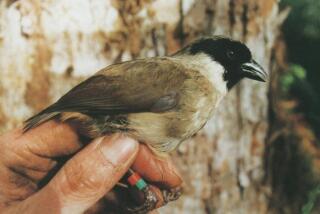Seychelles Tries to Preserve What’s Left of Fast-Disappearing Exotic Natural Heritage : Ecology: Dozens of species of flora and fauna have been eradicated since colonizers appeared in the 1750s.
- Share via
CERF ISLAND, Seychelles — People in the Seychelles have a saying that translates into, “Look, don’t touch, but appreciate.”
So it’s appropriate that signs in Creole and English on this tiny island in the St. Anne Marine National Park say just that, underlining the government’s commitment to preserve what’s left of its exotic natural heritage.
Gen. Charles Gordon, who visited the Seychelles in 1881, depicted the islands as the Garden of Eden and its extraordinary fan-shaped coco de mer palm trees with their giant nuts, Tree of Knowledge.
Although this scattered archipelago of 115 islands is set in the azure Indian Ocean 1,000 miles from anywhere, dozens of species of flora and fauna have been eradicated since the first French colonizers, the first human inhabitants, appeared in the 1750s. The extinct include the sluggish dugong and the Nile crocodile.
Dozens more species are endangered, including the hawksbill and green turtles, slaughtered for their shells which, wrongly tagged tortoise shell, have been used to make everything from spectacle frames to jewelry.
“They are very mobile throughout the islands so we don’t really know how many there are, but a census in 1982 showed 2,000 breeding green turtles and less than 100 hawksbills,” said government scientist John Collie.
The turtles are listed as endangered by the Conference on International Trade in Endangered Species. In 1991 the Seychelles government stopped issuing licenses to catch them.
It now has a program to retrain and compensate craftsmen who make their living carving the shells. All sales of “tortoise shell” have been banned.
The World Bank has given $800,000 for research into the hawksbill and about $300,000 for the green turtle.
“Part of the money will be used for stock assessment,” said Collie. “We will also draw up a plan for managing turtle stocks . . . “
Collie said 13 bird species are on the government’s own endangered list, including the magpie robin and the black paradise flycatcher.
The government’s environment division offers a $6 bounty for killing European owls, which were brought in to the islands to kill rodents but instead slaughter indigenous owls.
Also on the government’s list are Caecilians, a small amphibious snake.
Although not endangered, the islands’ populations of giant tortoises live wild only on the southern island of Aldabra. Some of the creatures are 160 years old.
Annette Carlstrom, a Swedish botanist who is working in the islands for two years, said about 30 plant species are considered by the government to be in danger--”more than one-third of the flora.” But others are vulnerable.
The Seychelles lost most of its indigenous rain forests to shipbuilding in the 18th Century, although small pockets remain on the main island of Mahe and on another island, Silhouette.
More recently, creeping development and the over-cultivation of coconuts--the islands’ main cash crop--have cut the numbers of the coco de mer, which takes nearly 1,000 years to reach full size and produces nuts which resemble human female genitals. Local legend has it that male and female trees mate on stormy nights; it is considered unlucky for humans to be present.
Although the palms are not endangered, the government recently set up a register.
Endangered species include the jellyfish tree, which bears brown fruit shaped like jellyfish, and a giant timber tree known by its Creole name of bwa-d-fer, said Dr. Carlstrom, who is setting up the island’s first flora data base.
More to Read
Sign up for Essential California
The most important California stories and recommendations in your inbox every morning.
You may occasionally receive promotional content from the Los Angeles Times.













